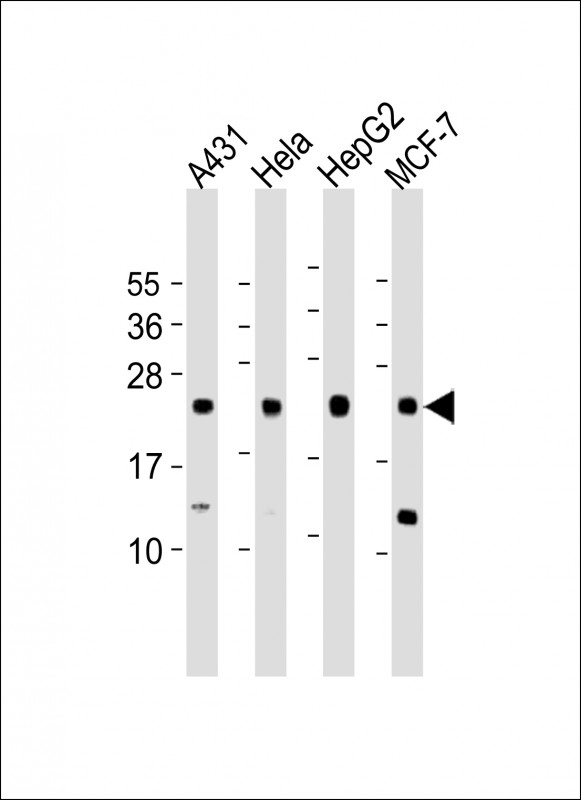LITAF Antibody (N-Term)
Purified Rabbit Polyclonal Antibody (Pab)
- 产品详情
- 实验流程
- 背景知识
Application
| WB, E |
|---|---|
| Primary Accession | Q99732 |
| Other Accession | Q9JLJ0, P0C0T0 |
| Reactivity | Human, Rat, Mouse |
| Predicted | Mouse, Rat |
| Host | Rabbit |
| Clonality | polyclonal |
| Isotype | Rabbit IgG |
| Calculated MW | 17107 Da |
| Gene ID | 9516 |
|---|---|
| Other Names | Lipopolysaccharide-induced tumor necrosis factor-alpha factor, LPS-induced TNF-alpha factor, Small integral membrane protein of lysosome/late endosome, p53-induced gene 7 protein, LITAF, PIG7, SIMPLE |
| Target/Specificity | This LITAF antibody is generated from a rabbit immunized with a KLH conjugated synthetic peptide between 31-60 amino acids from the human LITAF. |
| Dilution | WB~~1:1000 E~~Use at an assay dependent concentration. |
| Format | Purified polyclonal antibody supplied in PBS with 0.09% (W/V) sodium azide. This antibody is purified through a protein A column, followed by peptide affinity purification. |
| Storage | Maintain refrigerated at 2-8°C for up to 2 weeks. For long term storage store at -20°C in small aliquots to prevent freeze-thaw cycles. |
| Precautions | LITAF Antibody (N-Term) is for research use only and not for use in diagnostic or therapeutic procedures. |
| Name | LITAF |
|---|---|
| Function | Plays a role in endosomal protein trafficking and in targeting proteins for lysosomal degradation (PubMed:23166352). Plays a role in targeting endocytosed EGFR and ERGG3 for lysosomal degradation, and thereby helps down-regulate downstream signaling cascades (PubMed:23166352). Helps recruit the ESCRT complex components TSG101, HGS and STAM to cytoplasmic membranes (PubMed:23166352). Probably plays a role in regulating protein degradation via its interaction with NEDD4 (PubMed:15776429). May also contribute to the regulation of gene expression in the nucleus (PubMed:10200294, PubMed:15793005). Binds DNA (in vitro) and may play a synergistic role with STAT6 in the nucleus in regulating the expression of various cytokines (PubMed:15793005). May regulate the expression of numerous cytokines, such as TNF, CCL2, CCL5, CXCL1, IL1A and IL10 (PubMed:10200294, PubMed:15793005). |
| Cellular Location | Cytoplasm. Nucleus. Lysosome membrane; Peripheral membrane protein; Cytoplasmic side. Early endosome membrane. Late endosome membrane. Endosome membrane; Peripheral membrane protein; Cytoplasmic side. Cell membrane; Peripheral membrane protein; Cytoplasmic side. Golgi apparatus membrane. Note=Associated with membranes of lysosomes, early and late endosomes (PubMed:11274176, PubMed:27582497, PubMed:27927196). Can translocate from the cytoplasm into the nucleus (PubMed:15793005). Detected at Schmidt-Lanterman incisures and in nodal regions of myelinating Schwann cells (By similarity) {ECO:0000250|UniProtKB:Q9JLJ0, ECO:0000269|PubMed:11274176, ECO:0000269|PubMed:15793005, ECO:0000269|PubMed:27582497, ECO:0000269|PubMed:27927196} |
| Tissue Location | Ubiquitously and abundantly expressed. Expressed predominantly in the placenta, peripheral blood leukocytes, lymph nodes and spleen. |
For Research Use Only. Not For Use In Diagnostic Procedures.
Provided below are standard protocols that you may find useful for product applications.
BACKGROUND
Probable role in regulating transcription of specific genes. May regulate through NFKB1 the expression of the CCL2/MCP-1 chemokine. May play a role in tumor necrosis factor alpha (TNF- alpha) gene expression.
REFERENCES
Polyak K.,et al.Nature 389:300-306(1997).
Myokai F.,et al.Proc. Natl. Acad. Sci. U.S.A. 96:4518-4523(1999).
Moriwaki Y.,et al.J. Biol. Chem. 276:23065-23076(2001).
Ota T.,et al.Nat. Genet. 36:40-45(2004).
Bechtel S.,et al.BMC Genomics 8:399-399(2007).
终于等到您。ABCEPTA(百远生物)抗体产品。
点击下方“我要评价 ”按钮提交您的反馈信息,您的反馈和评价是我们最宝贵的财富之一,
我们将在1-3个工作日内处理您的反馈信息。
如有疑问,联系:0512-88856768 tech-china@abcepta.com.























 癌症的基本特征包括细胞增殖、血管生成、迁移、凋亡逃避机制和细胞永生等。找到癌症发生过程中这些通路的关键标记物和对应的抗体用于检测至关重要。
癌症的基本特征包括细胞增殖、血管生成、迁移、凋亡逃避机制和细胞永生等。找到癌症发生过程中这些通路的关键标记物和对应的抗体用于检测至关重要。 为您推荐一个泛素化位点预测神器——泛素化分析工具,可以为您的蛋白的泛素化位点作出预测和评分。
为您推荐一个泛素化位点预测神器——泛素化分析工具,可以为您的蛋白的泛素化位点作出预测和评分。 细胞自噬受体图形绘图工具为你的蛋白的细胞受体结合位点作出预测和评分,识别结合到自噬通路中的蛋白是非常重要的,便于让我们理解自噬在正常生理、病理过程中的作用,如发育、细胞分化、神经退化性疾病、压力条件下、感染和癌症。
细胞自噬受体图形绘图工具为你的蛋白的细胞受体结合位点作出预测和评分,识别结合到自噬通路中的蛋白是非常重要的,便于让我们理解自噬在正常生理、病理过程中的作用,如发育、细胞分化、神经退化性疾病、压力条件下、感染和癌症。






